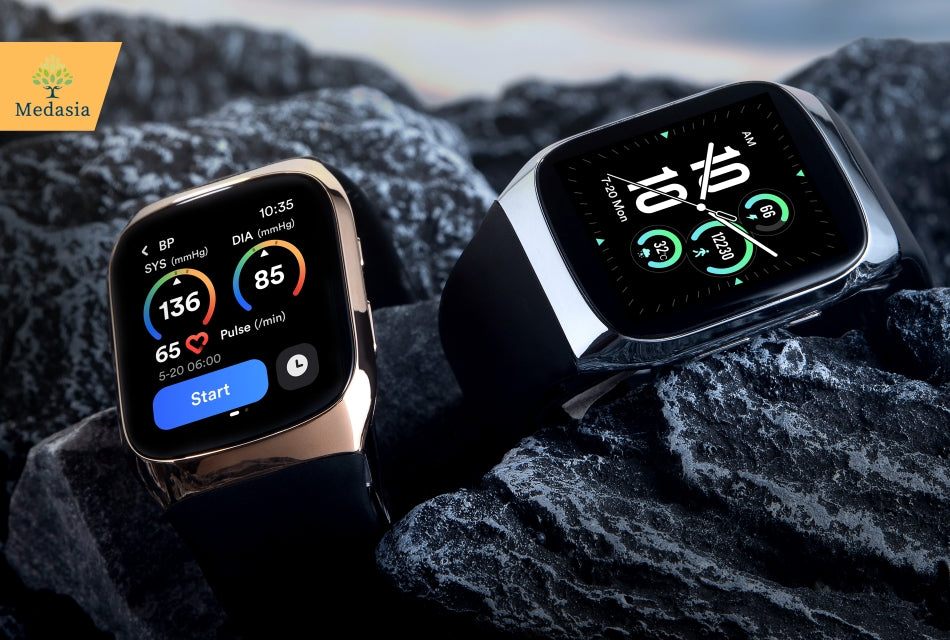Top 4 Popular Medical Wearables

The next 10 years mark the United Nations' "Decade of Healthy Aging" plan.
And we need the best-selling wearables to meet the growing demand:
1. Blood Pressure Smart Watch

- BP Monitoring: To test you just press a button, hold your hand over your heart, and the cuff will automatically inflate and deflate on its own. When it’s done, you can see a reading of your blood pressure on the screen.
- Sleep Tracking: The Sleep function doesn’t just keep track of your sleep. It also helps you create a schedule and a perfect bedtime routine so you can meet your sleep goals.
- Workout Tracking: Indoor running, Outdoor running, Indoor walking, you name it - MedAsia Smartwatch has a workout for it to get your endorphins going.The starting line is on your wrist.
- Calorie Tracking: Data such as steps, calories, speed,etc. can be obtained for each exercise. The exercise is morescientific and the data recording is more accurate.
2. Continuous Glucose Monitoring

- Accurate blood sugar measurement all day, with automatic chart recording.
- Easy and convenient to wear, compact in size.
- Comprehensive blood sugar analysis reports enable more accurate treatment by doctors and easier blood sugar management.
- Ability to remotely view the blood sugar data of family and friends.
3. Portable ECG Monitor
- Suitable for Both Individual and Family Use, Portable Design.
- Efficiently Helps Prevent Cardiovascular Diseases and Reduce Risks.
- Intelligent Design Enables Remote Health Management via Mobile App.
- Automated Measurement, ECG Storage, Data Upload, Health Conclusions, and Doctor Consultations.
4. All-In-One Arm Blood Pressure Monitor
- Compact, versatile and ultra-thinversatile design for convenience and portability.
- Monitor your blood pressure effortlessly wherever and whenever you need.
- Effortlessly wraps around the upper arm wirelessly, ensuring precise measurements.
- Seamless Bluetooth connectivity to a mobile app enables real-time blood pressure tracking.
- Provides comprehensive readings, including diastolic, systolic, and pulse rate.
Development And Challenges Of Medical Wearables
Investment and innovation are necessary to address the prevalence of common health conditions, often referred to as "silent pandemics," such as Alzheimer's disease, high blood pressure, diabetes, and depression. These conditions require diverse measurement and treatment options. While research on these conditions is extensive, they continue to significantly impact healthy aging.
In line with a 10-year strategy by the United Nations, efforts are being made to improve lives through coordinated actions that focus on age and aging, with particular attention given to data and innovation. Data is considered a valuable commodity in healthcare, often referred to as the new blood.
Therefore, capturing data for improved measurement and treatment is crucial during this decade of global efforts to enhance various health conditions.
A noteworthy trend in the field of data and diagnostics is the shift in the location of measurement and treatment. Digital technologies, such as wearable devices, are enabling a paradigm shift towards "hospitals without walls." This concept aligns with the idea of independent living, allowing patients to remain in their everyday environment without the need for frequent visits to hospitals or clinics. This approach offers two immediate benefits: it reduces the burden on patients who may have mobility and transportation limitations, and it optimizes clinicians' time, allowing them to focus on individuals requiring personal attention.
Additionally, by keeping patients at home, their regular habits can provide more informative data compared to sporadic assessments in clinical settings. Wearable technology plays a significant role in this context, enabling prolonged and remote data capture that leads to better insights and personalized healthcare approaches.

The Advancement of Wearables in Healthcare
Traditional clinical visits for data collection in clinical care are limited to capturing a single time point or a brief timeframe. These visits pose logistical and financial challenges for participants, especially those with severe health conditions.
However, the emergence of wearables enables continuous remote monitoring of patients' health data while they go about their daily lives. These innovative measurements provide valuable insights into disease physiology and outcomes. Furthermore, this new era of wearables-generated data allows for digital phenotyping, which involves quantifying individual patients using multimodal data from personal digital devices and contributes to the development of digital twins for precision medicine.
According to a study conducted by Masanneck et al. , the use of wearables in clinical care for chronic neurological disorders, including epilepsy, multiple sclerosis, Alzheimer's disease, and Parkinson's disease, has significantly evolved.
They analyzed trials registered on ClinicalTrials.gov and found that the relative frequency of clinical care utilizing wearables increased from 0.7% in 2010 to 11.4% in 2020. Additionally, Kaiser Associates projected that wearable sensors will be incorporated into up to 70% of clinical care by 2025 . Masanneck et al. also observed a shift in the types of digital measurements employed, with a progression from simple tracking methods, such as motor function and exercise patterns, to more complex measures like speech and cognition tracking.
These findings highlight the growing adoption of digital health technologies (DHTs) in neurology trials and the expansion of disease-specific digital measurements.

Overcoming Challenges and Enhancing Access
Wearables have revolutionized the landscape of clinical care, allowing them to take place anywhere and anytime. Decentralized and virtual trial settings have proven beneficial for patients by reducing the burdens associated with trial participation, such as travel time and costs, while also accelerating the pace of clinical research.
However, it is important to recognize that trials utilizing wearables may inadvertently create disparities and disadvantages for certain groups, particularly those with limited access to the internet or inadequate technology literacy. The Lancet and Financial Times Commission report on "Governing health futures 2030: Growing up in a digital world" emphasizes the need to invest in the enablers of digital transformation in public health and Universal Health Coverage, aligning with country roadmaps and working towards establishing a robust national digital infrastructure.
The existing digital divide exacerbates the disconnection from online services, further exacerbating the challenges faced by vulnerable populations. Bridging this divide requires the establishment of reliable and affordable internet infrastructure in highly vulnerable areas.
Addressing the barriers to access in decentralized and virtual clinical care is essential to ensure equitable participation and maximize the potential benefits of wearables. By investing in infrastructure and promoting digital inclusion, we can create a more inclusive and accessible environment for all participants, ultimately advancing the field of medical research.
Participant Verification and Ensuring Data Accuracy
The authentication of participants poses specific difficulties in the context of remote data collection in virtual clinical care. The utilization of wearables by individuals other than the intended subjects presents a significant risk to the reliability of data collected during the trials. Biometric authentication methods, such as fingerprint or iris scanners, have already been employed to accurately identify patients in on-site clinical care.
However, these technologies have yet to be extensively utilized in virtual clinical care, making them a potential key innovation in this field. Recent studies have successfully demonstrated that continuously acquired data itself can be employed for continuous authentication. For instance, artificial intelligence (AI) models can identify specific users by analyzing biometric data related to ambulation and heart rate collected through wrist-worn wearables.
Despite the availability of this technology, considerations regarding privacy and usability need to be addressed before their widespread implementation in clinical care.
In contrast to data collection in traditional laboratory settings, ensuring data quality remains one of the most significant challenges that affect the reliability of data obtained in real-world scenarios. Artifacts can arise from various sources, including the environment (e.g., elevated temperature readings when the device is covered by a blanket), the device itself, or the patient (e.g., incorrect placement of the devices).
Furthermore, the lack of complete data can also have a substantial impact on data quality, highlighting the importance of evaluating data completeness. For example, participants may choose not to wear a wrist sensor during sleep or during activities involving water, such as showering or swimming, if the sensor is not water-resistant.
Conclusion
Wearable technologies are becoming ever more popular as suggested tools for use in modern medicine. Studies evidence their growing pragmatism and provision of objective data for a more informative and personalised approach to patient care. Overall, wearables herald a new era in healthcare delivery to transform many aspects of clinical care.
PS: If you want my team to OEM your own medical wearables, please contact insights@medasiagroup.com
WE RECOMMEND
Related posts
- Subscribe MedInsights
- Subscribe MedInsights
- Subscribe MedInsights
- Subscribe MedInsights
- Subscribe MedInsights












